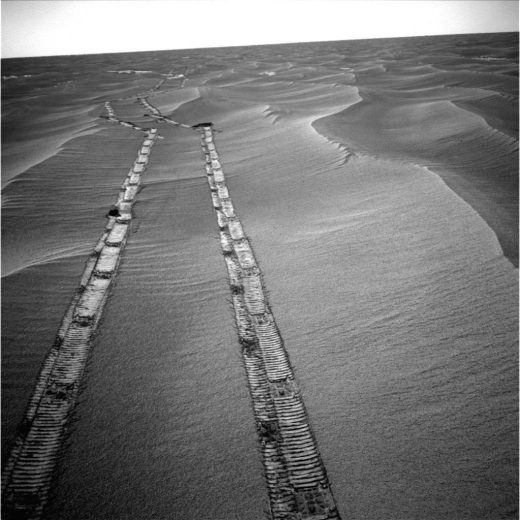After several months of futile efforts to contact Opportunity, which went silent last year during a dust storm that covered most of Mars, NASA today officially declared the end of the rover’s mission:
- NASA’s Record-Setting Opportunity Rover Mission on Mars Comes to End | NASA
- Opportunity did not answer NASA’s final call, and it’s now lost to us | Ars Technica
This video gives a brief review of Opportunity’s 15 years of exploration:
Opportunity left a long trail of accomplishments behind it: Look Back at Opportunity’s Record-Setting Mission – NASA
In this image from 2010, Opportunity used its navigation camera for this northward view of tracks the rover left on a drive from one energy-favorable position on a sand ripple to another. The rover team called this strategy “hopping from lily pad to lily pad.”
The Opportunity rover stopped communicating with Earth when a severe Mars-wide dust storm blanketed its location in June 2018. After more than a thousand commands to restore contact, engineers in the Space Flight Operations Facility at NASA’s Jet Propulsion Laboratory (JPL) made their last attempt to revive Opportunity Tuesday, to no avail. The solar-powered rover’s final communication was received June 10.
Designed to last just 90 Martian days and travel 1,100 yards (1,000 meters), Opportunity vastly surpassed all expectations in its endurance, scientific value and longevity. In addition to exceeding its life expectancy by 60 times, the rover traveled more than 28 miles (45 kilometers) by the time it reached its most appropriate final resting spot on Mars – Perseverance Valley.
The final transmission, sent via the 70-meter Mars Station antenna at NASA’s Goldstone Deep Space Complex in California, ended a multifaceted, eight-month recovery strategy in an attempt to compel the rover to communicate.
===
Meanwhile, activities of the other missions on Mars continue. The InSight lander in December deployed the seismometer and this week placed the heat probe onto the surface:
- NASA’s InSight Prepares to Take Mars’ Temperature – NASA JPL
- NASA InSight Mars Lander: Heat Probe on the Surface! – LeonardDavid.com
From the NASA JPL article:
NASA’s InSight lander has placed its second instrument on the Martian surface. New images confirm that the Heat Flow and Physical Properties Package, or HP3, was successfully deployed on Feb. 12 about 3 feet (1 meter) from InSight’s seismometer, which the lander recently covered with a protective shield. HP3 measures heat moving through Mars’ subsurface and can help scientists figure out how much energy it takes to build a rocky world.
Equipped with a self-hammering spike, mole, the instrument will burrow up to 16 feet (5 meters) below the surface, deeper than any previous mission to the Red Planet. For comparison, NASA’s Viking 1 lander scooped 8.6 inches (22 centimeters) down. The agency’s Phoenix lander, a cousin of InSight, scooped 7 inches (18 centimeters) down.
“We’re looking forward to breaking some records on Mars,” said HP3 Principal Investigator Tilman Spohn of the German Aerospace Center (DLR), which provided the heat probe for the InSight mission. “Within a few days, we’ll finally break ground using a part of our instrument we call the mole.”

===
Check out a selection of recent images of Mars from the Curiosity Rover: Curiosity Mars Rover: Scenic Shots – LeonardDavid.com

Credit: NASA/JPL-Caltech/MSSS
====
Chasing New Horizons: Inside the Epic First Mission to Pluto

